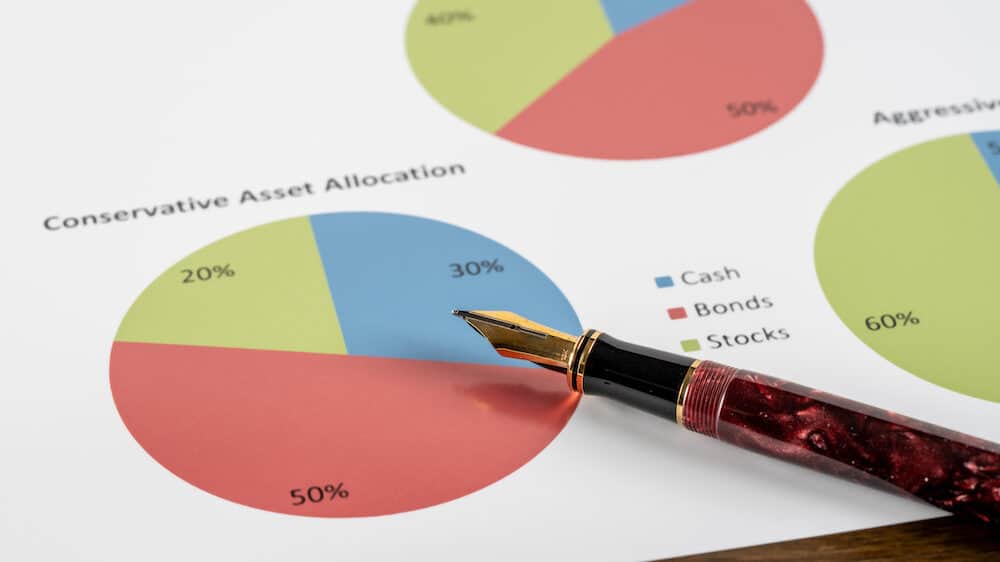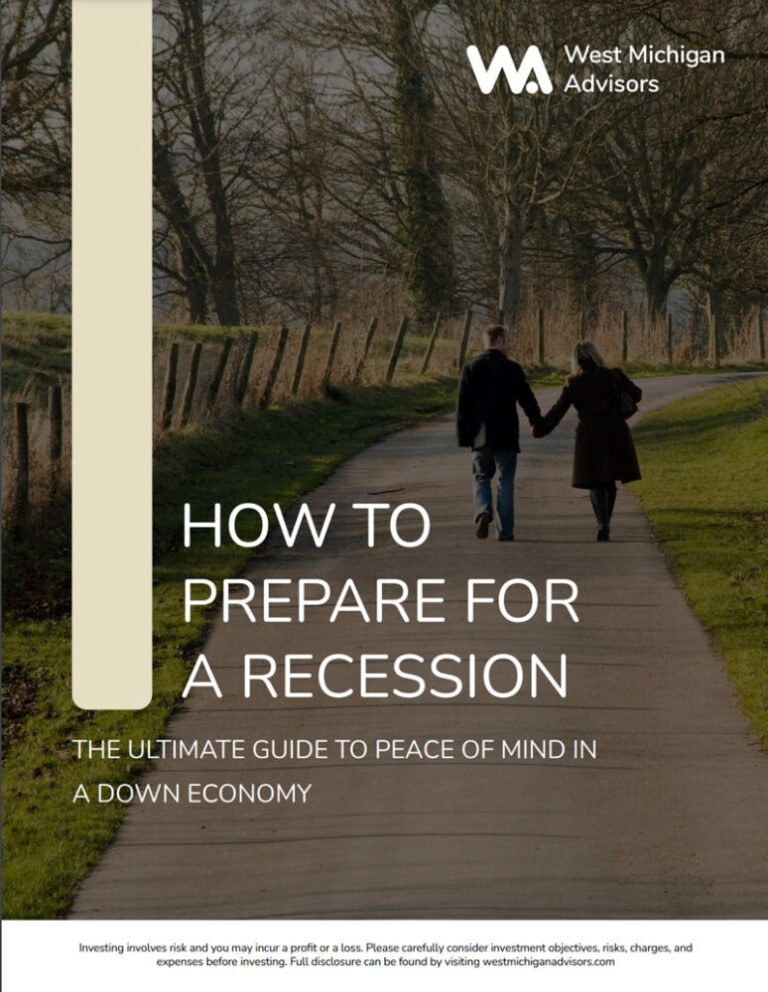If you’re concerned about the economy or stock market, you’re probably also worried about what’s happening in your retirement account. Do I have enough money to travel when I retire? Spend more time with the grandkids instead of working? Even just have the same quality of life my spouse and I are used to?
Uncertainty in the economy is stressful, whether you’re 20 or 60. And while it can have an impact on your financial future, it doesn’t always have a significant one.
There’s an easy way to ensure that you’re on the right track toward having what you need to retire—portfolio optimization. This can sound intimidating, but with a trusted financial planner like West Michigan Advisors, you can take the guesswork and confusion out of planning your retirement, even in an uncertain market.
In this blog, we’ll explore the ins and outs of your investment portfolio, the types of assets you’ll find in it, and how to optimize it so you can retire with confidence, whether retirement is decades down the road or just months away.
What Is a Portfolio?

If you have any sort of retirement fund set up, either on your own or through an employer, you have a portfolio of assets. A portfolio is the entire collection of financial investments that are contributing to your retirement.
An investment portfolio changes from person to person. Much of it depends on a person’s age and stage of their career. It also depends on how knowledgeable or hands-on someone is with their investments.
Having an understanding of what’s in your investment portfolio is a good first step toward portfolio optimization. Examine your retirement accounts to determine what you are currently investing in, and if you have questions, reach out to a financial advisor.
Choosing Portfolio Goals
When optimizing your portfolio, it’s important to also start with a goal in mind. Almost everyone wants to eventually retire. But no matter what age you are, you might also want to consider:
- Whether or not you’ll continue working part-time in retirement.
- Current debt you need to pay off.
- If you want to retire early (before the age of 65.)
- What you want to spend your retirement money on (travel, home, hobbies, etc.)
- How much money you estimate you’ll need per month in retirement.
Most of these and other goals are related to the growth and preservation of your assets. At West Michigan Advisors, we often hear clients concerned that they won’t have enough money for retirement. Optimizing your portfolio with your financial advisor can help ease that fear and lay out a plan to get you the money you need so you can rest easy in your golden years.
Creating a Portfolio Strategy
After you have determined your goals for retirement, it’s the perfect time to create a strategy for your portfolio. Financial advisors often use planning tools that factor in your current financial situation and project how much you will have in retirement depending on what and how you invest. Here are a few simple steps to take when creating a strategy:
- Look at what you currently have. Examine your current income, the money in your retirement account, and any debt you have.
- Establish your objectives. At this point, your financial planner may evaluate your risk tolerance, or how willing you are to invest in more volatile assets. Then, you can set up a plan to make sure you meet your financial goals when you need to.
- Decide on a strategy. Choose how you are going to allocate your assets. Your financial planner will help you diversify your portfolio and determine how much to invest in each.
- Stay on top of your plan. Meet with your advisor once a year to check in on the progress of your retirement plan—what’s working? What’s not? Decide what needs to change, and tweak your strategy.
Types of Assets in Your Portfolio
You have options for where you want to allocate your hard-earned money in your investment plan. Below is a breakdown of some of the most common types of assets you can have in a portfolio:
- Stocks. A share of a company or organization that you own a small percentage of, entitling you to a fixed dividend if the stock gains value.
- Bonds. Bonds are debts that corporations take on and return with interest. You can purchase a bond from a company and receive a guaranteed return when they pay the debt.
- Exchange Traded Funds (ETF). A collection of assets bought or traded during market hours. If you manage your retirement through an investment management company, you probably have ETFs in your portfolio.
- Commodity funds. Investment in raw materials. Gold and silver are popular investment commodities.
- Cash investments. Cash investments are like short-term savings accounts that gain returns in the form of interest typically in 90 days or less.
There are countless other types of assets, but these are the most common and effective.
Assessing Risk
With any type of investment, you have to be willing to take some risk. Assets like ETFs minimize risk, whereas stocks vary in how risky they can be. Some investments, like bonds, are almost completely risk-free.
When thinking about the risk you’re willing to take with your retirement, it’s important to keep in mind when you plan to retire. If you’re still young and in your early career, your portfolio can tolerate more risk. If you’re close to retirement, it’s often better to be more conservative.
Some of the riskiest investments include:
- Bitcoin and other cryptocurrencies. Cryptocurrency is an increasingly popular asset but incredibly volatile. It is set to become highly regulated in most parts of the world, and the price of cryptocurrency constantly changes.
- Illiquid assets. Being illiquid can be a precarious place for the average investor. Not having access to your money is a risk many overlook. Selling illiquid assets at the wrong time can lead to unexpected losses or penalties, especially in turbulent times. Examples may include penny stocks, some collectibles, real estate, or annuities with surrender charges.
- Derivatives. Derivatives rely on the future price of a stock, so they are much riskier to invest in as their price can fluctuate without notice.
- Equities. Equities are investments into a company, whether the company is just starting out or is trying to raise capital. A company cannot always guarantee a return on equity investments if its venture fails.
- Investing conservatively. Surprisingly, being too conservative with your investments is also risky. If your portfolio is not diversified or you’re taking no risk at all, you will see very little return.
Your financial advisor will help you assess the amount of risk you can and should take with your money. For example, at West Michigan Advisors, we create a risk assessment profile for each of our clients that gives us a snapshot of how their money should be invested.
Allocating Assets
Properly allocating your assets will ensure that you have a balanced portfolio that mitigates risk, aligns with your retirement goals, and can be easily measured each year. A financial advisor can help you properly allocate your assets based on the following models:
- 100% stock. All of your investment funds are in stock. This model is more highly-volatile but with a potential for high returns. These are typically called growth portfolios.
- 100% bond. All of your investment funds are in bonds. This model produces smaller returns but is far less volatile. These are typically called income portfolios.
Your financial advisor will probably not recommend one of these two extremes, but find a more balanced approach for your assets. You will also have the option to invest in more than one fund—for example, you can allocate a portion of your assets into the stock market, a portion into bonds, and a portion into international stocks. Your financial advisor can monitor each fund and determine how and when they yield returns.
Managing Your Portfolio
If you currently work with a financial advisor for something other than retirement planning, chances are they can help you manage your portfolio as well. Before you choose a financial advisor, determine what sort of help you want with your portfolio. There are several different approaches:
- Active management. You or your financial advisor will actively buy undervalued stocks to sell when their price rises.
- Passive management. You or your financial advisor will stick to less volatile stocks that have more long-time value.
- Discretionary management. Your financial advisor takes full control over your portfolio and makes decisions they believe are best for you and informs you on those decisions.
- Non-discretionary management. Your financial advisor counsels you on making decisions about your portfolio but does not make those decisions themselves.
Can I Withdraw Money from My Portfolio?
The short answer is yes, you can, but you should be aware of fees and tax penalties. If you’re taking money out of your funds before you retire, you have to be careful that you’re still meeting your financial goals for retirement and don’t run out of money.
We recommend that you let your money grow in the account until you retire, and then make a plan with your financial advisor upon retirement about how and when you will take out the money you need.
How Does the Market Impact the Decisions I Make About My Portfolio?
Currently, the United States is in a bear market, which means it’s better to sell than to buy. Markets like this can make investors panic easily as prices continue to drop. So what does that mean for your investment portfolio?
A common misconception among investors is that “If the market is tanking, then so is my retirement savings.” But that’s not always the case—the market is constantly fluctuating, and a decrease now doesn’t mean a decrease in your portfolio forever. That’s why it’s important to work with your financial advisor annually to make sure you’re still on track.
Knee-jerk reactions to changing markets are never an effective strategy. What’s most important is to make sure you’re still on the right track. During uncertain financial times, West Michigan Advisors has made it a priority to review portfolios more often to make sure our clients are still meeting their goals, even in a volatile market.
Let Your Advisor Lead the Way to Portfolio Optimization
In this blog, we talked about why portfolio optimization is important and how to do it. There are a lot of moving parts when it comes to managing your assets, but here’s the good news—you don’t have to do it alone. At West Michigan Advisors, we help Michiganders of all stages of life in their financial planning so they can relax and look forward to spending retirement doing what they love. If you want to learn more about optimizing your portfolio, schedule a free call with one of our advisors today.
The material has been gathered from sources believed to be reliable, however West Michigan Advisors cannot guarantee the accuracy or completeness of such information, and certain information presented here may have been condensed or summarized from its original source. To determine which investments or planning strategies may be appropriate for you, consult your financial advisor or other industry professional prior to investing or implementing a planning strategy. This article is not intended to provide investment, tax or legal advice, and nothing contained in these materials should be taken as such. Investment Advisory services are offered through West Michigan Advisors. Advisory services are only offered where West Michigan Advisors and its representatives are properly licensed or exempt from licensure. No advice may be rendered unless a client agreement is in place.










